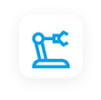“Robots will harvest, cook, and serve our food. They will work in our factories, drive our cars, and walk our dogs.” - Gray Scott
This statement is not out of a sci-fi story. Robots are real. We are quickly moving toward the age of automation in several industries, including agriculture.
About 735 million people faced hunger in 2022. With the looming prospect of feeding 10 billion mouths worldwide by 2050, farming and food industries must become more sustainable, necessitating fundamental changes in the entire supply chain.
Fortunately, farmers have turned to modern technology for sustainable large-scale food production. Agriculture robots, aka agribots, equipped with hi-tech sensors are revolutionizing the agriculture industry by increasing crop yield and overall efficiency while reducing manual labor.
The Agricultural Robots Market size, estimated at USD 13.24 billion in 2023, is expected to reach USD 24.50 billion by 2028.
While farming robots have a vast array of applications, let’s discuss some of their most popular uses.
Efficient Harvesting
Harvesting is one of the central farming activities and a repetitive, labor-intensive one. Automation in harvesting brings several benefits, such as higher yield, reduced labor costs, and reduced wastage.
Automated harvesting is a complicated task that requires a combination of several sensors that:
• Detect and locate fruit or crop
• Determine its ripeness
• Measure its distance
• Pick the produce
Currently, harvesting robots are used to harvest vegetables and fruits. They have cameras and sensors to detect their ripeness and use robotic arms to harmlessly pick the produce.
Precision Seeding and Irrigation
Planting seeds is a repetitive and monotonous task, which is perfect for automation.
Driverless tractors and Autonomous Mobile Robots (AMRs) are generally used for smart seeding. Instead of the traditional “scatter and hope for the best” method, they use GPS-based sensors to sow seeds at the optimal depth and spacing.
Another problem with traditional farming is the wastage of water, resulting in global water scarcity. To tackle this issue, robots with smart sensors can monitor soil moisture levels and water only specific plants, saving gallons of water.
Automated seeding and irrigation also significantly cut down greenhouse gas emissions associated with agriculture. Win-win for both farmers and the Earth!
Effective Weeding
Throughout centuries, farmers have used plowing and tilling for weed control, but they disrupt soil balance and nutrients. Not to mention, they are cumbersome and time-consuming processes.
Another popular method is no-till weeding, where a high amount of herbicides are used, making weeds more resistant over time.
However, robots are now eliminating these tedious tasks. Equipped with computer vision and LiDAR sensors, image processing and ML algorithms, and mechanized arms, weeding robots separate weeds from crops and remove them with high precision.
Not only does robot-assisted weeding save precious time and labor, but it also does it in an efficient and eco-friendly manner.
Real-Time Data Collection using LiDAR Sensors
Farming is not limited to planting seeds, irrigating, and harvesting.
Farmers also need to monitor plant and soil conditions regularly to ensure high yield and reduce wastage, which is a tedious and time-consuming process.
But thanks to LiDAR-powered robots, collecting and analyzing data is a piece of cake. LiDAR sensors provide precise information to agribots in real-time to perform complex processes such as soil analysis, weeding, and environmental monitoring quickly and reliably.
Additionally, LiDAR-based robots can be used to perform several other tasks, such as
• Precision Agriculture
• Mapping and Surveying
• Cattle Herding
Sorting and Packing
Harvesting is not the end of the farming process. After the produce has been harvested, sorting and packing are performed by several workers. In the fast-moving production environment, there is a high demand for manual laborers to perform these processes.
Instead, companies are increasingly using conveyor belts and robotic arms to pack fruits and vegetables for retail distribution.
Robots sort and pack the products according to type. They are even equipped with sensors that detect and remove bad produce, allowing only the best items to reach the supermarket shelves.
Automate Farming Processes with Hokuyo Sensors
With an exponential increase in the human population, bridging the food gap requires adopting modern agriculture methods that use process automation on a large scale. Farming robots with highly accurate sensors can help us realize this target by producing high yields with minimal resources.
At Hokuyo, we offer quality sensors for a range of robotic applications in several industries, such as manufacturing, logistics, agriculture, and more.
You can find a range of sensors used for agribots in our product inventory, such as laser rangefinders (LiDAR), obstacle detection sensors, optical data transmission devices, and collision avoidance sensors.
Contact us to learn more about our products and help you build your smart agribot.

 Factory Automation
Factory Automation Logistics Automation
Logistics Automation Process Automation
Process Automation Crane Collision Avoidance
Crane Collision Avoidance LiDAR/Obstacle Detection
LiDAR/Obstacle Detection Safety Laser Scanners
Safety Laser Scanners Optical Data Transmission
Optical Data Transmission Hot Metal Detectors
Hot Metal Detectors Laser Distance Sensor
Laser Distance Sensor Blog
Blog Whitepapers
Whitepapers Case Studies
Case Studies Infographics
Infographics